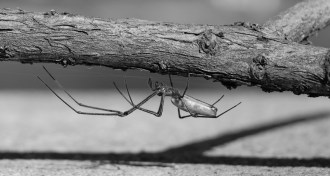News
-
 Neuroscience
NeuroscienceMagnets in helmets might make football safer
The repulsive force of magnets in football helmets could slow the impact of collisions, reducing concussion danger and making the game safer.
-
 Planetary Science
Planetary ScienceTwo travelers from far beyond Neptune return home
Two bodies approaching from the edge of the solar system may have been tossed out there by Jupiter over 4 billion years ago.
-
 Environment
EnvironmentSpiders enlisted as pollution sensors for rivers
Hunting arachnids provide a better picture of chemical threats to food web.
By Beth Mole -
 Life
LifeStudy finds lack of evidence for infanticide link to monogamy
A new study contradicts idea that the rise of infanticide among mammals drove the evolution of monogamy.
By Susan Milius -
 Climate
ClimateLightning strikes will surge with climate change
Climate warming could boost lightning strikes in the United States by roughly 50 percent over the next century.
-
 Neuroscience
NeuroscienceStopped brain clock saves memory in hamsters
Broken timekeeper in brain may explain some memory problems, hamster study suggests.
By Meghan Rosen -
 Astronomy
AstronomyPhilae lander reveals stunning, unsettling view of comet
Concerns are surfacing about the Rosetta mission lander Philae’s ability to fully explore comet 67P/Churyumov-Gerasimenko.
-
 Astronomy
AstronomyRosetta mission lander set to explore surface of comet
The Rosetta spacecraft’s minifridge-sized lander Philae is now on comet 67P/Churyumov-Gerasimenko and is beginning to study its geology and chemistry.
-
 Genetics
GeneticsHuman thoughts control mouse genes
Human brain waves trigger light that activates protein production in rodents.
-
 Genetics
GeneticsGenes tell tale of cat domestication
A peek into cats’ genetic makeup may help reveal how hissing wild felines became purring tabbies.
-
 Astronomy
AstronomyRosetta’s countdown to comet landing has begun
Everything is on track for Rosetta mission scientists to attempt to set the Philae lander on the surface of comet 67P/Churyumov-Gerasimenko.
-
 Environment
EnvironmentThirdhand smoke poses lingering danger
Harmful cigarette chemicals that linger on surfaces, known as thirdhand smoke, can go on to pollute the air and may harm people’s health.
By Beth Mole